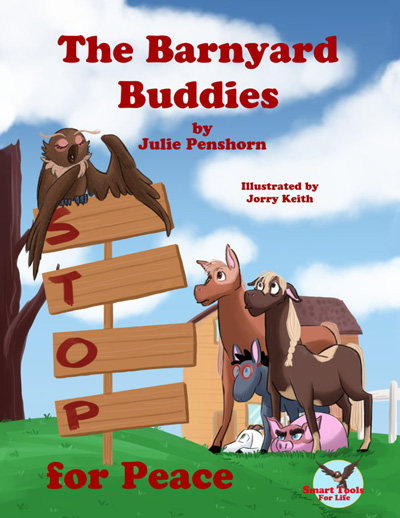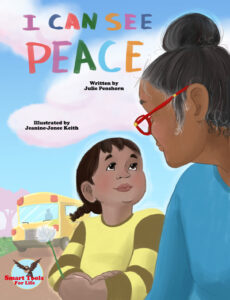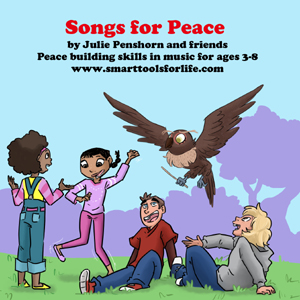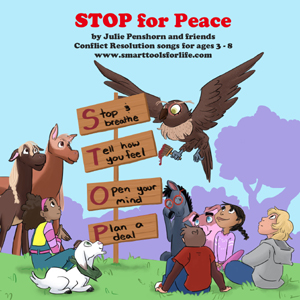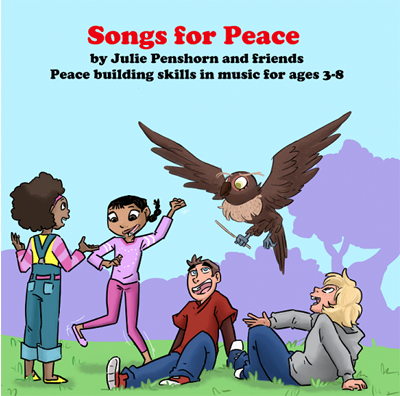Track from “I STOP for Peace”. Music and short children’s dialogues make learning fun and easy.
Conflict transformation in our families can be life-changing.
What do you do when you have a problem with a spouse or child? Most of us can’t claim great skills for working it out. Most of us never learned how. Kids are learning, however. Often it’s not until fourth grade, but most children get some education in conflict resolution at school. In this article, I’ll catch you up to what they are learning and give you four simple steps to use that will transform the conflicts in your home. These steps are appropriate for you, and even for your three-year-old.
In this ever-more complicated world, inter-personal conflicts and inter-familial conflicts may be what causes us the most anguish. Transforming our conflicts is a key to our happiness and is critical for our children’s futures.

What’s the difference between conflict resolution and conflict transformation?
Conflict transformation benefits from sharing deeply. For partners, it is important to talk about the underlying feelings of fear, hurt, sadness, loneliness, worry, or frustration, rather than trying to be right. It’s far more beneficial to demonstrate to spouse and onlooking kids that you care about each other than it is to show them you can win an argument.
The transformation of children’s conflicts requires the same things, with one more important component. A valid solution is not a top-down solution. Often conflict resolution is. For example, a resolution imposed by a more powerful country or individual (such as a teacher or parent) is now “resolved” but it’s not “transformed”. That may be why it usually reappears! Top-down solutions lack buy-in and often result in imperfect resolutions. Conflict transformation implies that people work to a solution that can actually help them move beyond the current anger and hostility to a much greater relationship having come to a deeper understanding. They are ready and able to move beyond where they started.
Tough times can be opportunities to partner with family.
Using our tough times as opportunities, we can find partners in family members. Of course, you don’t want to share every problem with young children. It may cause anxiety. However, they appreciate knowing, as an example, that you are sad or angry because you can’t go to work, and you love your job. They like to understand that whatever you are bothered by is not their fault. That is reassuring. So, some sharing invites more collaboration from members of your family. Even three-year-olds often have wonderful help to offer! “Dad, don’t worry! I can keep you company if you’re lonesome for your work friends.” Or, “Mom, I want to be your work partner today. Let’s plant the garden.”
Missing interaction with peers can cause slower social skill development
Since kids who have missed interacting with their peers lately are missing valuable social and emotional learning, you get to home-school it. To build better relationships and skills for dealing with others in school, home, or the workplace, you can help them learn the valuable skills to transform conflicts from sentences of isolation to opportunities for connection. It takes practice. And, like baseball or tennis, the more kids practice, the better they will be as adults, and the more likely they will be to have work and social success. The skills they learn help prepare them for more happiness and deeper relationships.

As children are isolated from others, including their grandparents, social skills can suffer.
You can reduce the impact of Covid-19 isolation on your kids.
To ward off the impact of Covid-19 on our kids, we need to innoculate them against the PTSD and trauma experts expect them to suffer. (This article by Sonali Kohli offers a comprehensive look at the mental health consequences of Covid-19 for California’s children–a microcosm of those in the entire country.) You have the best medicine! Guide them with conflict transformation skills, skills for seeing peace, and help them find purpose in serving others. For this blog, the focus is on skills for conflict transformation. It is a key ingredient in social skill education. According to Nadine Burke Harris, who cites a longitudinal study in her TED talk, health, happiness, and even ability to earn a living are at stake.
Learning versus teaching. . .
Kids are not interested in being “taught”, but they are fully ready to “learn.” What hampers buy-in for kids is being told to do something. They want to discover it! They want to know, “What’s in it for me?” It’s definitely helpful if they see the benefit of learning to work out problems. Thus, experiencing you and your spouse or friend working out problems and celebrating your success is a great way for kids to learn. However, when they are working it out with someone, not you, and you interfere too much it will be YOUR solution and they won’t learn nearly as well.
The capable parent sometimes helps too much.
Well-meaning, capable parents (who remind me of me, so this hits me first-hand), sometimes don’t let kids do the struggling, the seeking, the challenging work of finding peace themselves. Instead, they are coaching and solving all the time. It’s hard! Try to see not helping as part of the educational journey for all. As your child develops independence with the skills, you will be impressed!
Use a story to do the teaching.

The Barnyard Buddies STOP for Peace children’s book illustrates and inspires conflict transformation as it teaches through story.
There is research about the benefits of storytelling as a tool for teaching. Do a Google search and you’ll see more than enough to convince you! Here is a lovely article on the topic. Using stories, parents don’t even have to “teach.” by taking yourself out of the equation, you reduce the likelihood of a power struggle preventing learning (“Mom wants me to do this, so I will say ‘No.'”).
Start with a good story about stopping!
Because I felt so strongly about the need for a story to empower young children to solve their problems, I wrote the children’s book, “The Barnyard Buddies STOP for Peace.” If you like, read the reviews to see how other parents and teachers have been using this book, and why. Since I am a singer and songwriter, I added a musical component. The “I STOP for Peace” CD or electronic music offers a real-life story with young kids singing and telling it.
The “STOP for Peace” process offers conflict transformation for all ages.

Conflicts over scarce resources can be transformed at the peace table.
Establish your own special place for working out problems–maybe a peace table!
“Since children are concrete learners, they appreciate having a specific place designated for problem-solving or conflict resolution. The peace table is in that space, which becomes a respected and appreciated area representing empowerment, not punishment.” (Janke, Penshorn, 1995, page 40. From our 1995 book, “Peacemaker’s A, B, Cs for Young Children: A Guide for Teaching Conflict Resolution With a Peace Table” by Rebecca Janke, M.Ed. and Julie Penshorn which is out-of-print, but a few copies are available by emailing julie@smarttoolsforlife.com.).

After we stop and breathe we can sit at a peace table and work it out.
Decorate your peace table
It’s helpful to place the peace table in a space where the steps for conflict resolution can also be posted. You can use the coloring page on the home page of this site or order a full-color version in our store. Children often enjoy decorating their peace table. There are more ideas on Pinterest. Of course, if you’re not at home you can just use whatever is handy (such as a rock, a talking piece, an upturned bucket) as a peace table. You are just looking for an energetic focal point.
A peace table in your home reduces whining, tattling, and bullying, and increases kids’ power to succeed in life. It gives them the confidence to try even more peacemaking, and wage peace in more ways.
Parents and teachers can dampen children’s enthusiasm.
Compare these requests: 1). “Sam, you and Jamal go to the peace table and work this out.” or 2). “Sam, you and Jamal will have time to go to the peace table after lunch. Do you think you will be cooled off by then?” The second feels quite different but uses almost the same words. Teaching is a bit like filling a helium balloon. You fill it with love, fill it with stories, fill it with role modeling, and then, ultimately, you can just let it go and it will fly!
Adults and children can both use the peace table but don’t interfere with the children unless the conflict involves you.
Steps for the STOP for Peace process
Step 1: Stop and breathe.
Start by stopping to breathe and calm down. Here’s a song to help guide young children. The CD or E-music is available here.
It may take some time to cool off. It’s going to take a least 20 minutes for the chemicals in the brain to settle down, so don’t rush the process. Tell your conflict partner you need time to cool off and then demonstrate deep breathing for him or her. Especially if it’s a child. Your demonstration does a great deal to aid the learning process.

Conflict transformation can begin by getting back to personal peace with breathing.
Step 2: Tell how you feel.
Use an I-message when you are ready to work it out. See this blog for an extensive look at this step and how it relates to developing empathy in kids. This step is the essence of the work. Once you care enough to learn how each other feels your compassion is inspired and you have done most of the hard work.
Guard against making the other person responsible for your feelings. You have your feelings. They are yours. no one “made” you have that feeling. That’s why the format of the I-message tries to avoid using the word “you”. It’s not, “You make me sad because you are ignoring me.” It works much better to use something like, “I feel sad when I am left alone to work on my schoolwork alone for too long.” Active listening includes repeating what your conflict partner has said, so you are sure you fully understand and they are honored by your deep listening and respect of their feelings.
Step 3: Open your mind.
This is the brainstorming phase. If your children don’t write yet, they can still be independent at the peace table process. They can draw a picture of their ideas or ask you for help writing down their ideas. When brainstorming, don’t evaluate. Don’t censor. Just write down every idea, even if it seems to be a crazy thing. Then, in the next step, you will edit, combine, or eliminate ideas that don’t fit the criteria.
Step 4: Plan a deal.
Any good solution has to be good for me, good for you, and good for the community (from “Peacemaker’s A, B, Cs for Young Children: A Guide for Teaching Conflict Resolution with a Peace Table”). Applying this standard helps make sure the solution is workable and sustainable. Be sure to celebrate your success in making a plan! After reaching a resolution, it’s great to celebrate overtly, like by having a “problem-solving-pizza-party,” or a “solution-special-snowshoe-trip,” or a “transformation-time-TV-show”. If your solution doesn’t work out, go back to step O, Open your mind. Brainstorm some more ideas, choose one, and try again!
Peace education is a comprehensive approach to children’s mental health.
It gives children something to be “for” rather than spending all their energies focusing on all the challenges they face. It fits under the umbrella of SEL (social and emotional learning) beautifully but goes beyond. Instead of just seeking skills for getting along, it positions kids to build a purposeful future. Seeking personal and interpersonal peace, doing kind and compassionate acts, being generous, and taking creative, positive actions all contribute to this way of life. Show your enthusiasm for children’s efforts to be peacemakers!

